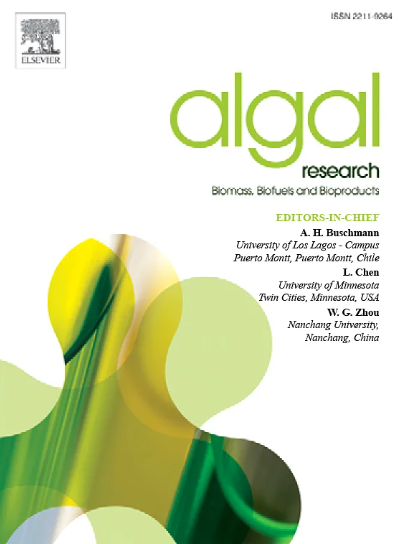HPTLC hyphenated with planar effect-directed assays (EDA) for the rapid screening and evaluation of macro algae fermentation with respect to their antioxidant and anti-inflammatory activity
IF 4.6
2区 生物学
Q1 BIOTECHNOLOGY & APPLIED MICROBIOLOGY
Algal Research-Biomass Biofuels and Bioproducts
Pub Date : 2025-02-25
DOI:10.1016/j.algal.2025.103978
引用次数: 0
Abstract
Marine algae or seaweed are among the ocean's most valuable sources of bioactive compounds. They grow abundantly in harsh marine environments of high salinity, high oxygen concentrations and extreme sunlight. The lack of oxidative damage in their structural components indicates the presence of highly effective antioxidants and anti-inflammatory compounds.
This study examines the effect of microbial fermentation on the phytochemical composition and bioactivity in different solvent extracts from marine algae via HPTLC microchemical derivatization and HPTLC bioautography. Microchemical derivatization with anisaldehyde/sulfuric acid was used to assess the extract complexity, DPPH free radical assay to estimate and detect antioxidant activity, and enzymatic bioassay to detect and estimate anti-inflammatory activity via COX-1 enzyme inhibition. The red alga sample was selected for further characterisation due to higher amounts of bioactive compounds.
The potency of the extract with the highest COX-1 inhibition was evaluated, with the high-maximal inhibitory concentrations (IC50) determined by an HPTLC-based experimental procedure developed in our lab. The IC50 values for COX-1 enzyme inhibition from both fermented and nonfermented extracts were significantly lower compared to the IC50 for salicylic acid as a reference standard. Six chromatographic zones exhibited bioactivity: 1,3,4, 6–8 zones with antioxidant activity and 4, 6–8 zones with anti-inflammatory activity. Compounds from bioactive zones were isolated using preparative TLC. They were further characterised using Fourier transform infrared (FTIR) spectroscopy, nuclear magnetic resonance (NMR) spectroscopy, and liquid chromatography-mass spectrometry (LC-MS).
The main constituents identified as responsible for antioxidant activity were polypeptides (zone 1), hydrolysed lignin (zone 3), carotenoids (zone 4), macrocyclic 4-pyrones (zone 6), fatty acids (zones 6 and 7) and their diglycerides (zone 8).
求助全文
约1分钟内获得全文
求助全文
来源期刊

Algal Research-Biomass Biofuels and Bioproducts
BIOTECHNOLOGY & APPLIED MICROBIOLOGY-
CiteScore
9.40
自引率
7.80%
发文量
332
期刊介绍:
Algal Research is an international phycology journal covering all areas of emerging technologies in algae biology, biomass production, cultivation, harvesting, extraction, bioproducts, biorefinery, engineering, and econometrics. Algae is defined to include cyanobacteria, microalgae, and protists and symbionts of interest in biotechnology. The journal publishes original research and reviews for the following scope: algal biology, including but not exclusive to: phylogeny, biodiversity, molecular traits, metabolic regulation, and genetic engineering, algal cultivation, e.g. phototrophic systems, heterotrophic systems, and mixotrophic systems, algal harvesting and extraction systems, biotechnology to convert algal biomass and components into biofuels and bioproducts, e.g., nutraceuticals, pharmaceuticals, animal feed, plastics, etc. algal products and their economic assessment
 求助内容:
求助内容: 应助结果提醒方式:
应助结果提醒方式:


